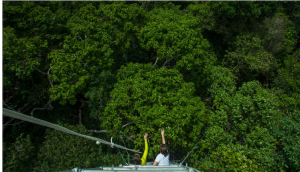Amazon Rainforest Absorbing Less Carbon Than Expected
New study finds that insufficient nutrient supply has not been properly accounted for in ecosystem models
Agriculture, forestry, and other types of land use account for 23% of human-caused greenhouse gas emissions, yet at the same time natural land processes absorb the equivalent of almost a third of carbon dioxide emissions from fossil fuels and industry, according to the International Panel on Climate Change, which issued the first-ever comprehensive report on land and climate interactions earlier this month. How long will the Amazon rainforest continue to act as an effective carbon sink?

View from the top of a measurement tower, where researchers monitor critical forest canopy processes such as photosynthesis, plant water fluxes, leaf characteristics, and growth.
An international team of scientists, including climate scientists from the Department of Energy’s Lawrence Berkeley National Laboratory (Berkeley Lab), investigated this question and found that accounting for phosphorus-deficient soils reduced projected carbon dioxide uptake by an average of 50% in the Amazon, compared to current estimates based on previous climate models that did not take into account phosphorus deficiency. The Amazon Basin is critical to help mitigate climate change due to its trees absorbing around a quarter of the CO2 released each year from the burning of fossil fuels.
The paper, “Amazon forest response to CO2 fertilization dependent on plant phosphorus acquisition,” was published August 5 in the journal Nature Geoscience.
“Most predictions of the Amazon rainforest’s ability to resist climate change are based on models that have outdated assumptions; one of those is that a sufficient supply of nutrients such as phosphorus exist in soils to enable trees to take in additional CO2 as global emissions increase,” said Berkeley Lab research scientist and study co-author Jennifer Holm. “But in reality the ecosystem is millions of years old, highly weathered, and therefore depleted of phosphorus in many parts of the Amazon.
Researchers involved in the AmazonFACE project monitored tree growth and leaf development aboveground, and tracked root growth and activity within soils belowground at a study site north of Manaus, Brazil where ambient CO2 concentration is planned to be artificially elevated to enable a realistic investigation of how future CO2 concentrations will affect the ecosystem.
“Our improved models now take into account these complexities, and could serve to help paint a more realistic portrayal of how the Amazon, and the tropics in general, will be impacted by climate change and the ability of trees to remove greenhouse gases from the atmosphere,” Holm said.
Source: Berkeley Lab
- 235 reads
Human Rights
Ringing FOWPAL’s Peace Bell for the World:Nobel Peace Prize Laureates’ Visions and Actions

Protecting the World’s Cultural Diversity for a Sustainable Future

The Peace Bell Resonates at the 27th Eurasian Economic Summit

Declaration of World Day of the Power of Hope Endorsed by People in 158 Nations

Puppet Show I International Friendship Day 2020

